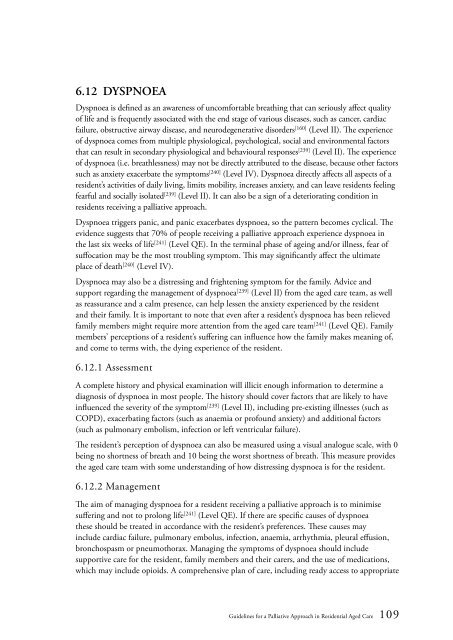Guidelines for a Palliative Approach in Residential Aged Care
Guidelines for a Palliative Approach in Residential Aged Care
Guidelines for a Palliative Approach in Residential Aged Care
Create successful ePaper yourself
Turn your PDF publications into a flip-book with our unique Google optimized e-Paper software.
6.12 DYSPNOEA<br />
Dyspnoea is def<strong>in</strong>ed as an awareness of uncom<strong>for</strong>table breath<strong>in</strong>g that can seriously affect quality<br />
of life and is frequently associated with the end stage of various diseases, such as cancer, cardiac<br />
failure, obstructive airway disease, and neurodegenerative disorders [160] (Level II). The experience<br />
of dyspnoea comes from multiple physiological, psychological, social and environmental factors<br />
that can result <strong>in</strong> secondary physiological and behavioural responses [239] (Level II). The experience<br />
of dyspnoea (i.e. breathlessness) may not be directly attributed to the disease, because other factors<br />
such as anxiety exacerbate the symptoms [240] (Level IV). Dyspnoea directly affects all aspects of a<br />
resident’s activities of daily liv<strong>in</strong>g, limits mobility, <strong>in</strong>creases anxiety, and can leave residents feel<strong>in</strong>g<br />
fearful and socially isolated [239] (Level II). It can also be a sign of a deteriorat<strong>in</strong>g condition <strong>in</strong><br />
residents receiv<strong>in</strong>g a palliative approach.<br />
Dyspnoea triggers panic, and panic exacerbates dyspnoea, so the pattern becomes cyclical. The<br />
evidence suggests that 70% of people receiv<strong>in</strong>g a palliative approach experience dyspnoea <strong>in</strong><br />
the last six weeks of life [241] (Level QE). In the term<strong>in</strong>al phase of age<strong>in</strong>g and/or illness, fear of<br />
suffocation may be the most troubl<strong>in</strong>g symptom. This may significantly affect the ultimate<br />
place of death [240] (Level IV).<br />
Dyspnoea may also be a distress<strong>in</strong>g and frighten<strong>in</strong>g symptom <strong>for</strong> the family. Advice and<br />
support regard<strong>in</strong>g the management of dyspnoea [239] (Level II) from the aged care team, as well<br />
as reassurance and a calm presence, can help lessen the anxiety experienced by the resident<br />
and their family. It is important to note that even after a resident’s dyspnoea has been relieved<br />
family members might require more attention from the aged care team [241] (Level QE). Family<br />
members’ perceptions of a resident’s suffer<strong>in</strong>g can <strong>in</strong>fluence how the family makes mean<strong>in</strong>g of,<br />
and come to terms with, the dy<strong>in</strong>g experience of the resident.<br />
6.12.1 Assessment<br />
A complete history and physical exam<strong>in</strong>ation will illicit enough <strong>in</strong><strong>for</strong>mation to determ<strong>in</strong>e a<br />
diagnosis of dyspnoea <strong>in</strong> most people. The history should cover factors that are likely to have<br />
<strong>in</strong>fluenced the severity of the symptom [239] (Level II), <strong>in</strong>clud<strong>in</strong>g pre-exist<strong>in</strong>g illnesses (such as<br />
COPD), exacerbat<strong>in</strong>g factors (such as anaemia or profound anxiety) and additional factors<br />
(such as pulmonary embolism, <strong>in</strong>fection or left ventricular failure).<br />
The resident’s perception of dyspnoea can also be measured us<strong>in</strong>g a visual analogue scale, with 0<br />
be<strong>in</strong>g no shortness of breath and 10 be<strong>in</strong>g the worst shortness of breath. This measure provides<br />
the aged care team with some understand<strong>in</strong>g of how distress<strong>in</strong>g dyspnoea is <strong>for</strong> the resident.<br />
6.12.2 Management<br />
The aim of manag<strong>in</strong>g dyspnoea <strong>for</strong> a resident receiv<strong>in</strong>g a palliative approach is to m<strong>in</strong>imise<br />
suffer<strong>in</strong>g and not to prolong life [241] (Level QE). If there are specific causes of dyspnoea<br />
these should be treated <strong>in</strong> accordance with the resident’s preferences. These causes may<br />
<strong>in</strong>clude cardiac failure, pulmonary embolus, <strong>in</strong>fection, anaemia, arrhythmia, pleural effusion,<br />
bronchospasm or pneumothorax. Manag<strong>in</strong>g the symptoms of dyspnoea should <strong>in</strong>clude<br />
supportive care <strong>for</strong> the resident, family members and their carers, and the use of medications,<br />
which may <strong>in</strong>clude opioids. A comprehensive plan of care, <strong>in</strong>clud<strong>in</strong>g ready access to appropriate<br />
<strong>Guidel<strong>in</strong>es</strong> <strong>for</strong> a <strong>Palliative</strong> <strong>Approach</strong> <strong>in</strong> <strong>Residential</strong> <strong>Aged</strong> <strong>Care</strong> 109
















